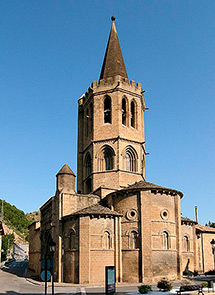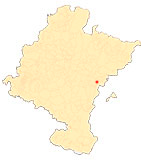The Gateway of Santa María de Sangüesa
By Clara Fernández-Ladreda Aguadé
|
THE ARTISTS. THE WORKSHOP OF SAN JUAN DE LA PEÑA AND THE WORKSHOP OF SCHEMATIC FIGURES |
|
presentation
The doorway of Santa María de Sangüesa belongs to the church of the same name, one of the most important works of urban Romanesque architecture in Navarre. The temple must have been begun around 1131, as a result of the donation made that year by the Navarrese-Aragonese monarch Alfonso I the Battler to the Order of St. John of Jerusalem of the palace he had in the town, on whose site it was built, continuing until around 1230, by which time it would have been almost finished. Later, in the second third of the 13th century, the dome and the spire that tops it were erected, but already in the Gothic style.
Since ancient times, this doorway has enjoyed great fame both in Navarre and abroad. Moreover, the restoration carried out during the years 2005-2009 has not only slowed down its deterioration process and provided abundant information on different aspects -polychromy, inscriptions-, but has also allowed us to better appreciate its qualities, thus increasing its popularity.
For the general public, its appeal is based above all on its abundant and rich subject matter, full of characters and episodes whose meaning escapes them, and which -for that very reason- awaken their curiosity and arouse their interest. In the eyes of an "ordinary" viewer, this monument is basically a narrative in images, a sort of comic book full of fabulous and exotic elements that contrast sharply with the reality that surrounds him and allow him for a moment to escape from boredom and everyday problems and let his fantasy fly. Paradoxically, if this observer is informed by a specialist and comes to know what is really represented, the story does not lose attractiveness and amenity but gains in both, because reality surpasses fiction in many cases, and the fabulous aspects continue to persist, which, when well explained, are even more fantastic: in other words, the public, besides learning, continues to be entertained, continues to "have a good time".
For the specialist, its value lies basically in the employment of some formal characteristics -pointed arch, longitudinal arrangement of the figures in the archivolts and the presence of statues-columns-, which are very advanced for the period in Spain, since, although in our country we are still at the beginning of the late Romanesque, these features are taken from French Gothic doorways. In fact, it is the first Navarrese doorway to offer such elements and in some cases -such as the statues-columns-, perhaps Hispanic. Hence the interest it has aroused among art historians, especially foreigners -particularly French-, which is also encouraged by the Gallic origin of the first master who worked on it, Leodegario, and by the question of his filiation and his relations with French sculpture of the early Gothic period.












